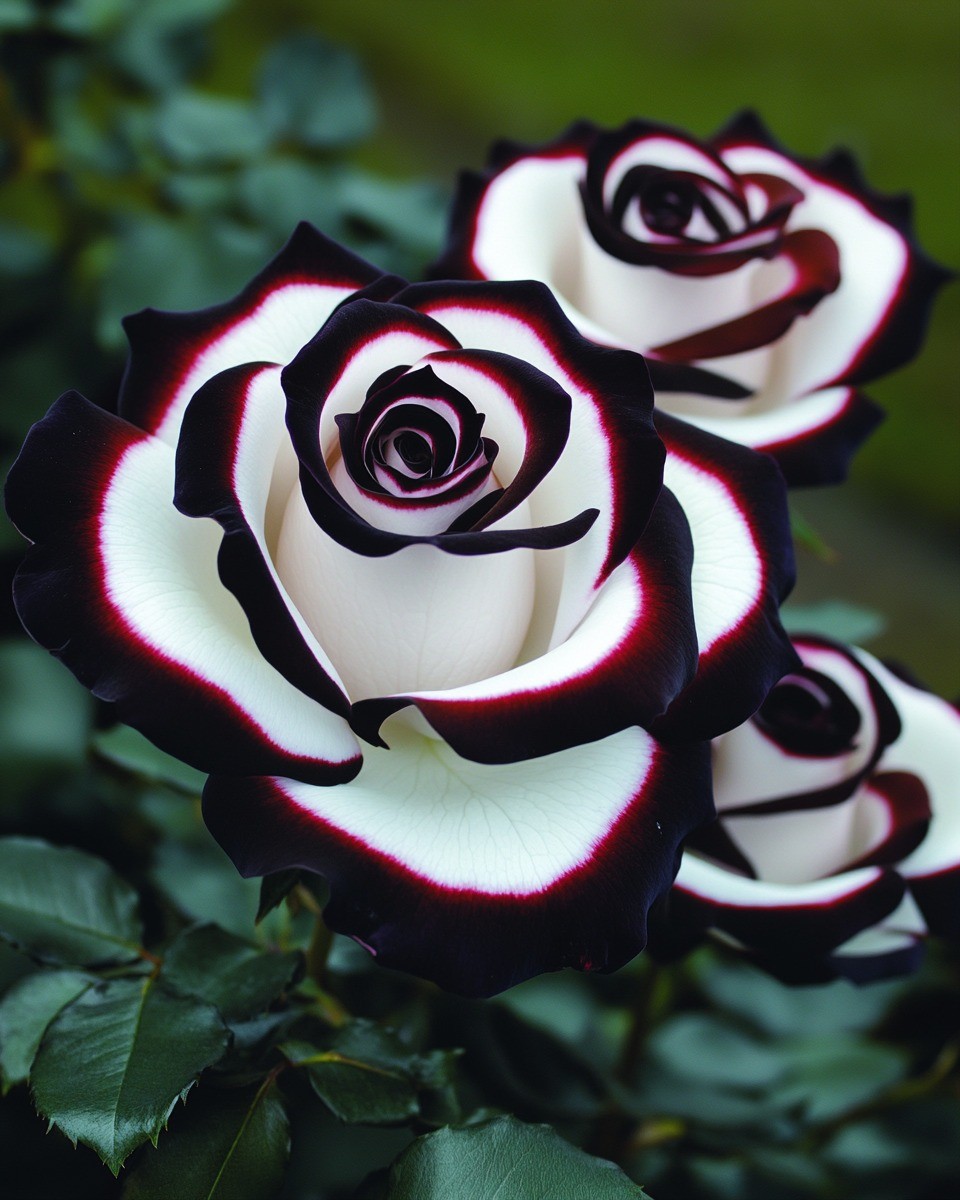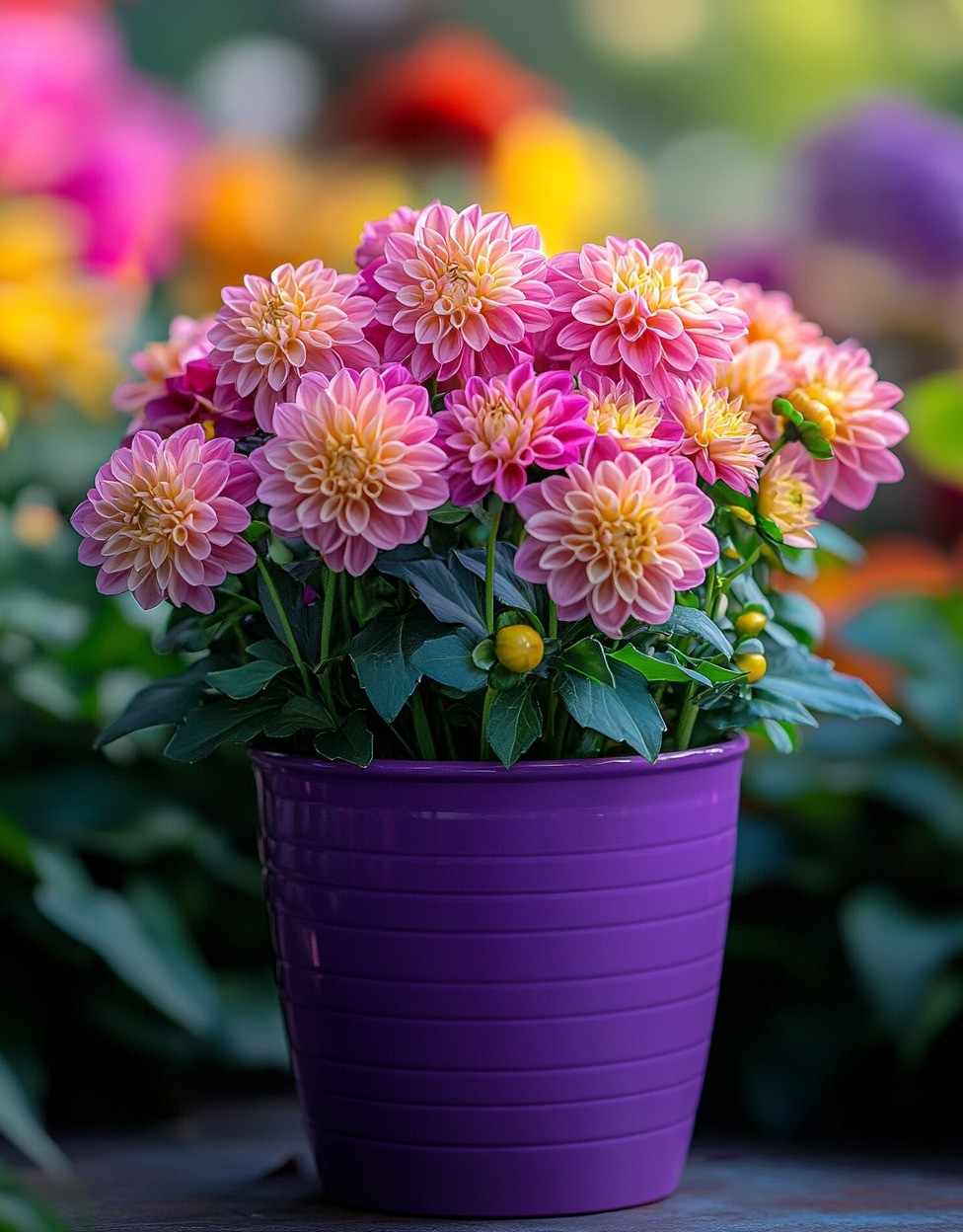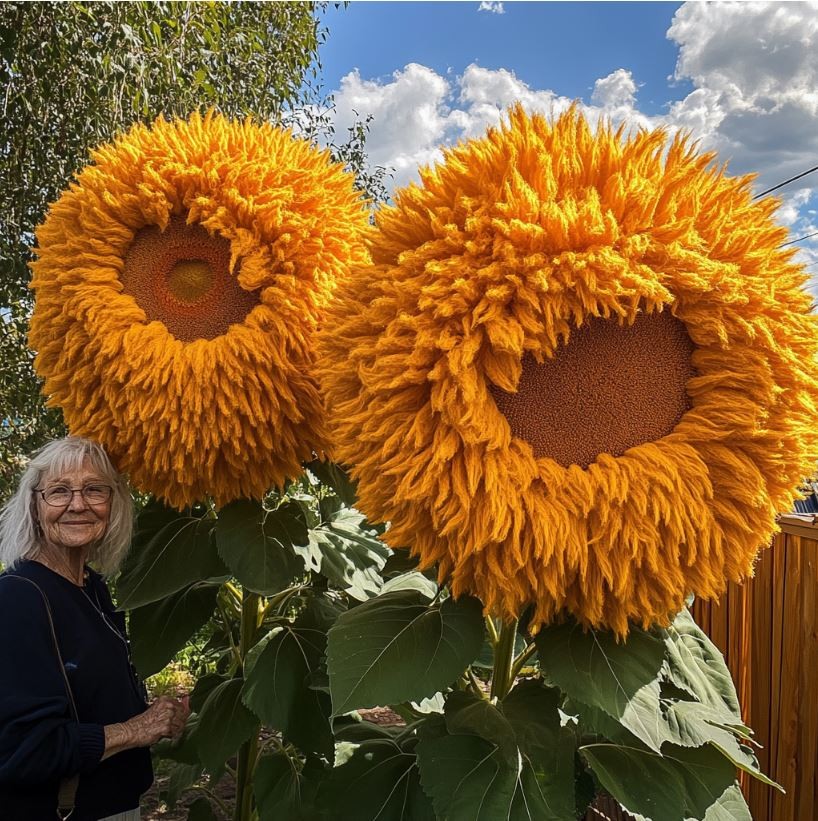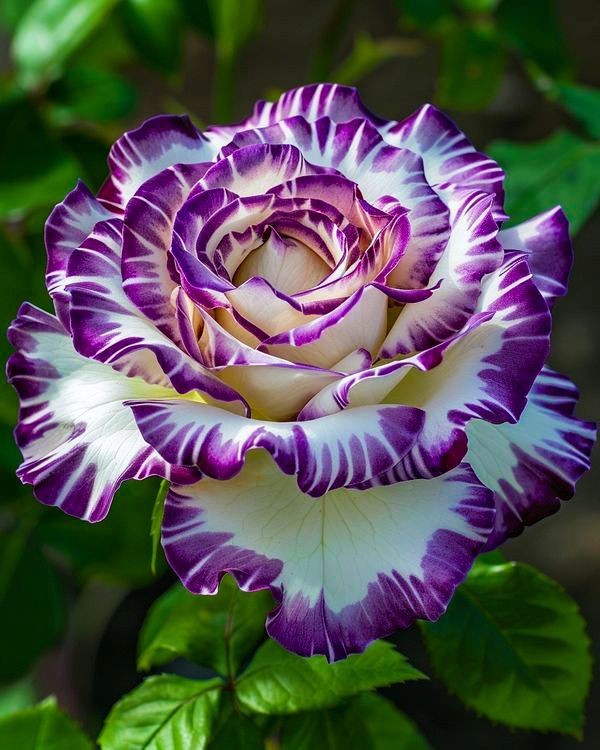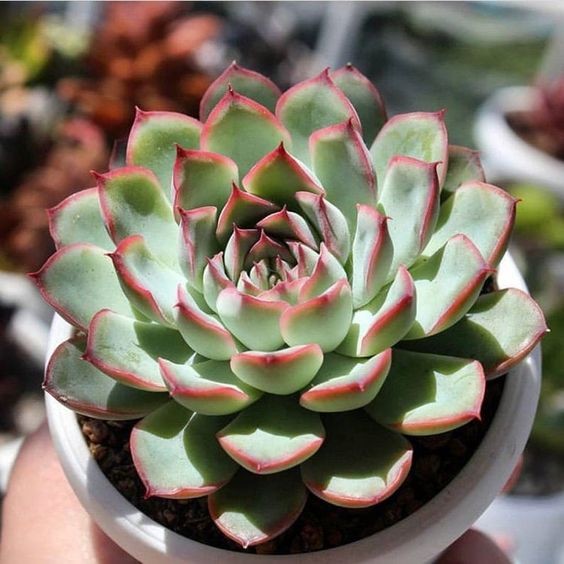The Rose is the most popular perennial flowering plant, grown in individual stalks, shrubs, and climbing, or trailing. Symbol of romance throughout the world, the deeply colored petals make roses one of the most popular and well-known plants among the general public.
Roses are classified in the genus Rosa, in the plant family Rosaceae that includes more than 300 naturally occurring rose species as well as tens of thousands cultivated varieties.
The very intensive breeding work of the last decades has led to an overwhelming diversity of varieties within the roses. Tea roses, hybrid teas, old roses and new roses – the taxonomy of rose varieties can seem a bit confusing, especially for hobby gardeners who want to choose their first garden roses.
With such wide variety of growing habits and a broad range of colors, it can be quite overwhelming to pick favorite rose type for Your garden. After all, the chosen one should not only correspond to your personal taste of the flower color, shape or fragrance, but also depends on the growing conditions.
For better orientation and to give you some suggestions regardless of the variety, we have therefore put together some roses for you according to their growth and function in the garden. Whether climbing roses, ground-covering roses, fragrant roses or hybrid tea roses – you will find your favorite rose variety.
Read on to learn more about the countless types of rose shrubs to decide what kind of rose to grow in your garden or landscape.
30 gorgeous Varieties of roses To Grow In Your Garden
Below is an extensive list of rose varieties you will find roses of many different colors and forms. Knowing about these many options will allow you to choose the rose plant that is best for you.
In order to give you an overview of the variety of roses, we would like to briefly explain the differences between the individual rose classes and groups. We also present some of the most beautiful varieties in a quick run-through for each category.
Whether you succumb to the charm of old and English roses or to the perfect flowers of modern varieties, or climbing roses and creepers, or ground cover roses you will undoubtedly find the rose you need!
Cultivated Roses
Cultivated roses are often referred to as modern roses. This term references any rose variety made available after the year 1867. Roses that have been around longer that that are called old-fashioned roses or antique roses.
To further add clarity there are a few terms we should cover before diving into the modern roses. These terms are catchalls that do not describe a specific cultivated group but rather any rose sharing certain physical characteristics.
For example, shrub roses are simply a generalized group of roses that grow with a shrub form and don’t fit well into another class. Rambling or climbing roses are simply the varieties that have the ability to grow as climbing vines. Likewise, groundcover roses are spreading, low-growing varieties that act as ground covers rather than shrubs.
For the following roses are not listed based on the general categories listed above. Instead they are organized by the identifiable group they belong to. Within these groups you may find shrub, climbing, and ground cover varieties. But these are not the defining features of each class as a whole.
These groups are some of the most popular commercially available roses around. They are as follows.
Read on to see examples for each of these gorgeous rose groups.
Polyantha Roses
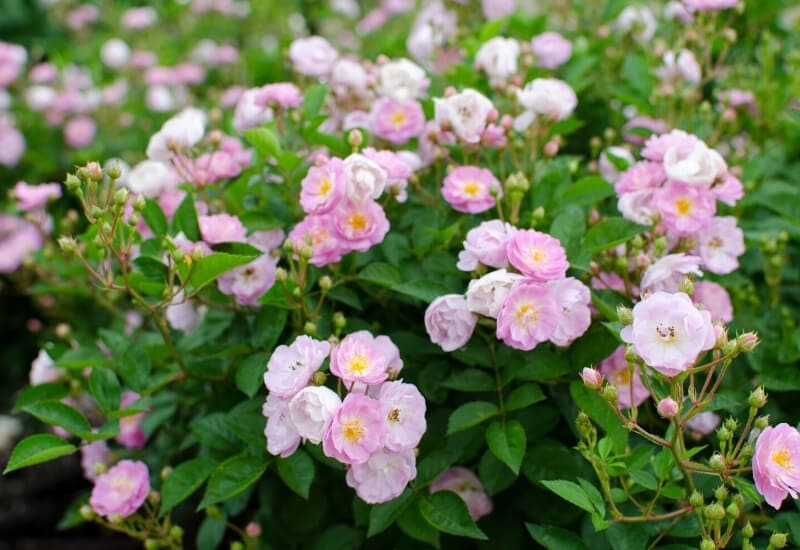
It is hard to stand out among roses for flowers along. Polyantha roses employ a different tactic.
This type of roses are more hardy than other groups and they require minimal care. Polyantha roses have smaller flowers than other roses. But these flowers make themselves known. They appear in high quantities and persist for most of the year.
Polyantha roses typically have a small compact form, but they can grow as a climbing vine as well. Below are some polyantha roses you should know.
Rosa ‘The Fairy’ (Polyantha Rose)
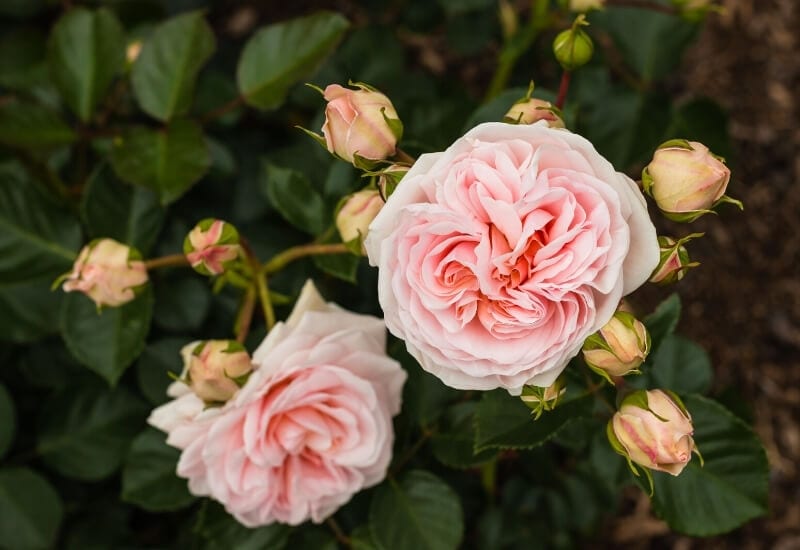
This award-winning rose variety has appealing flowers and foliage. It is also a dwarf variety making it a good option for those with limited garden space.
The flowers on polyantha rose are quite numerous. They bloom repeatedly throughout the summer with some blooms lasting into fall. Each flower has countless pink petals clustered around a central stamen.
The leaves are dark and have a glossy texture. Their shape is like a pointed oval with subtle serration.
Polyantha rose prefers full sun but compared to other roses, it is much more tolerant of shade. It can also survive some occasional droughts and is resistant to many diseases.
Overall, this small shrub has a compact rounded form with plenty of color throughout the growing season.
Rosa ‘Climbing Mademoiselle Cécile Brünner’ (Climbing Polyantha Rose)
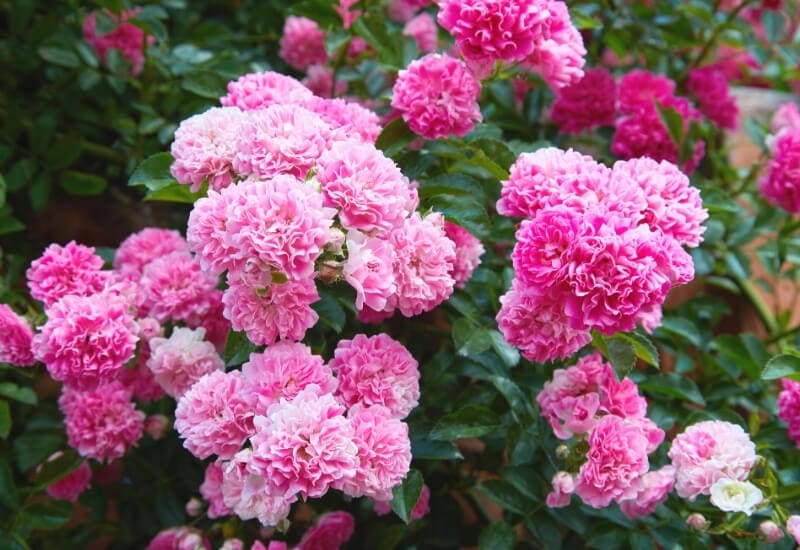
This versatile polyantha rose variety can grow as a shrub or be trained as a climbing vine. As a vine it reaches abound 20 feet tall. As a shrub it is often only eight feet in total height.
The variety known as ‘Climbing Mademoiselle Cécile Brünner is adaptable to poor, nutrient-deficient soils. It can also grow in either full sun or partial shade conditions.
Dark green deciduous foliage sets a neutral background color for the show blooms of this rose. These flowers are about one and a half inches and have a pale pink color. The petals tend to curl at the edges bringing a ruffled texture to the flowers.
Hybrid Tea Roses
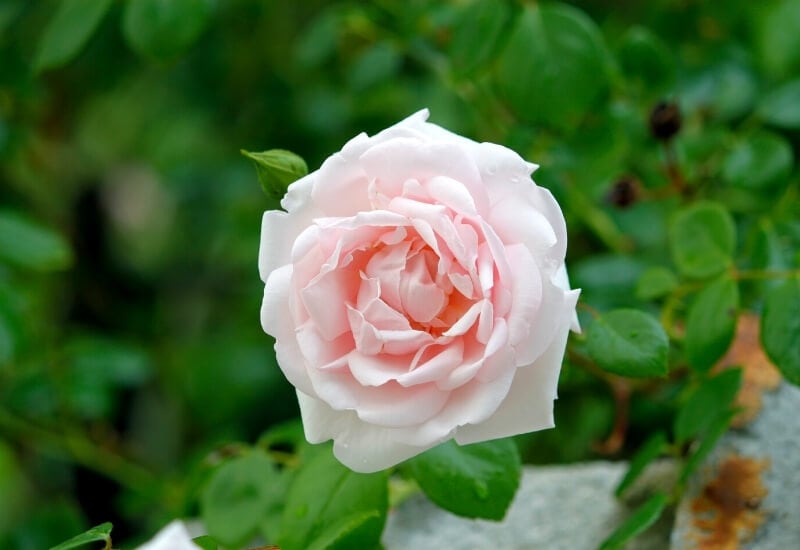
When it comes to the so called “modern garden rose” groups, hybrid tea rose is a good place to start. This cross between old-fashioned tea roses and hybrid perpetual roses combines inter hardiness with optimal blooms.
Proof of the hybrid tea rose’s attractiveness is the fact that these roses are the most popular group of roses in the world. These are the quintessential roses that even non gardeners recognize.
Hybrid tea roses feature the classic long stems each holding one deeply colored bloom. These flowers are meant to be cut. As such, they grow less like a dense shrub and instead have a very open habit.
Read on to learn why hybrid tea roses are famous throughout the world.
Rosa ‘Peace’ (Hybrid Tea Rose)
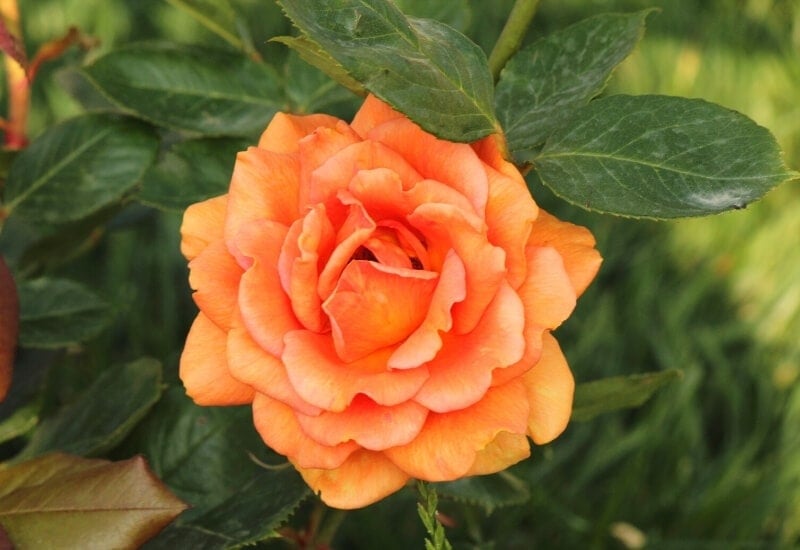
Among hybrid tea roses, the variety called ‘Peace’ is a medium-sized shrub with an upright habit. Its flowers have an exceptional coloration with an ombre effect.
This effect is subtle. Each of the numerous petals is pink at the tip. This color gradually changes to a near white at the base of the petal. These petals can also show a pale gold color.
Solitary flowers bloom at the end of long stems, Sometimes these blooms have a sweet fragrance. But this scent is not always present.
The leaves of this hybrid tea rose emerge as green with a slight red tint. As the season presses on, this becomes a pure dark green.
Many people are interested in the long stems of this hybrid tea rose. However, in order to produce that effect, you need to carry out heavy pruning on this shrub.
Pruning should happen in later winter and can be severe if needed. It is far from unheard of to trim these rose bushes back to one foot in height.
Proper pruning can lead to the long stems that people desire. After achieving this form, you can take cuttings from this plant to create rose bouquets.
This variety has an interesting history, It was first revealed to the public on the day that the allied forces took control of Berlin during World War II. This marked a moment that signified a potential for European peace. In keeping with that sentiment, this hybrid tea rose carries the name ‘Peace’ to this day.
Rosa MISTER LINCOLN (Hybrid Tea Rose)
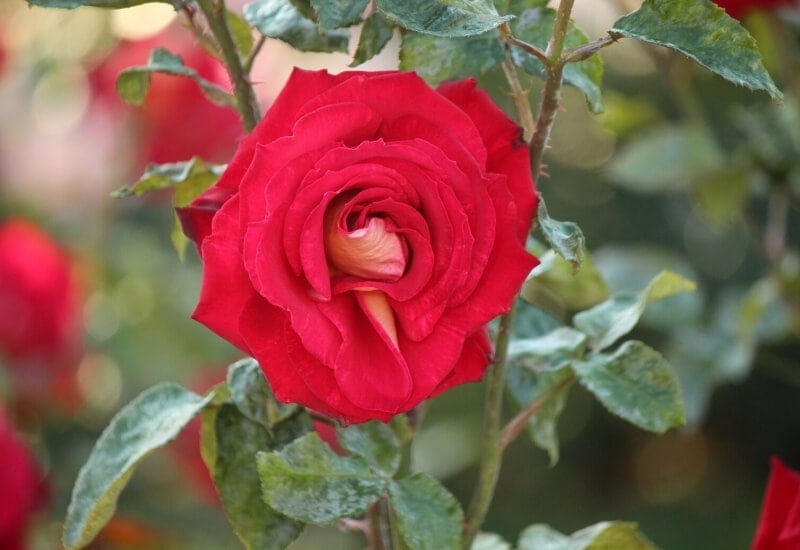
The MISTER LINCOLN hybrid tea rose is slightly larger than the ‘Peace’ variety. This hybrid as about additional foot in height and spread.
MISTER LINCOLN has dark green foliage and flowers that appear in pairs. These flowers are deep red in color.
This re-blooming rose variety results from a cross between Rosa ‘Chrysler Imperial’ and Rose ‘Charles Mallerin.’ The flowers are fragrant and can last until the first frost of the winter season.
Rosa ‘Dolly Parton’ (Hybrid Tea Rose)
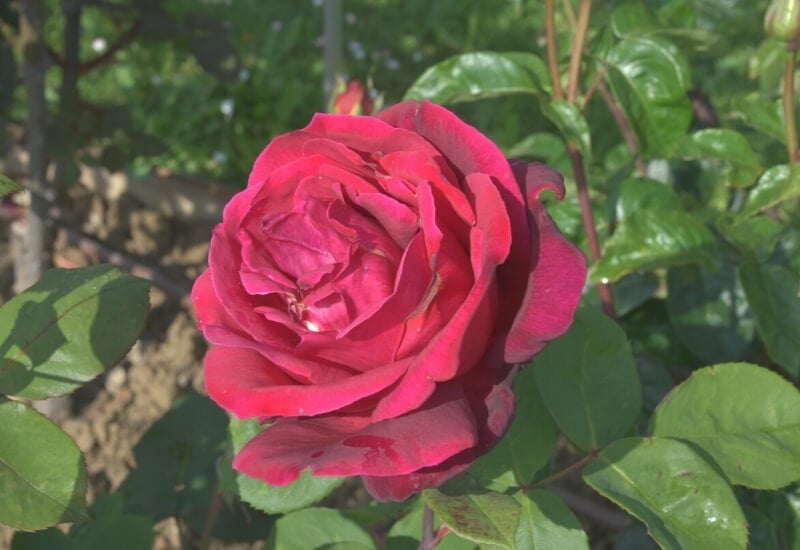
Like the last two, this third hybrid tea rose on our list is not lacking in name significance. This variety gained its patent in 1985 and is named after the country singer Dolly Parton.
This plant has a vigorous growth habit and takes the form of a small shrub. Its flowers are as fragrant as they are colorful.
The petals of these flowers are red with an orange tinge and appear in sets of about forty per flower. The flowers are large at half a foot in diameter.
‘Dolly Parton’ rose prefers a slightly acidic soil in full sun. It also appreciates a morning watering to keep its soil consistently moist.
Floribunda Roses
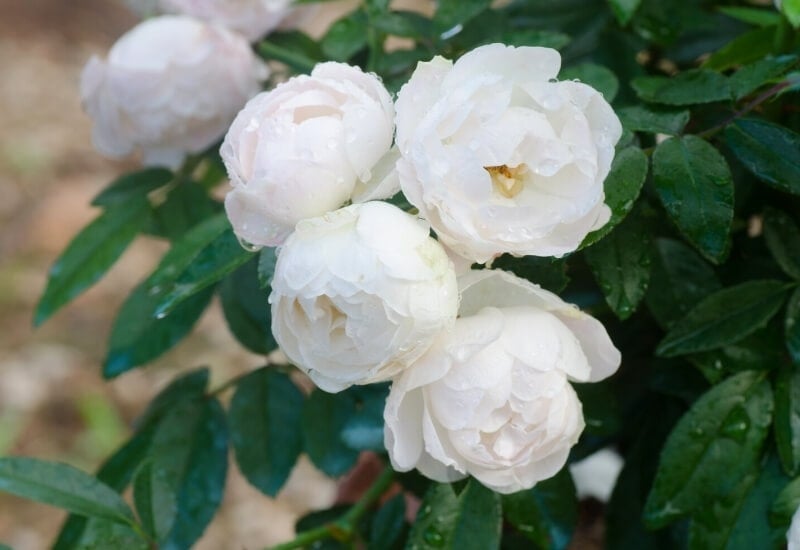
A student of the Latin language might guess that floribunda roses have an abundance of flowers. And they would be right.
Floribunda roses not only have many flowers per stem, the flowers bloom in continuous waves. You will likely notice them both by sight and by their strong scent.
To add to the value of floribunda roses, they also have a comparatively good disease resistance. Anyone who has tried to grow roses knows that disease is a serious concern.
This makes floribunda roses a good option for those not well-versed in disease prevention. Here are a few varieties you can try.
Rosa ‘Korbin’ ICEBERG (Floribunda Rose)
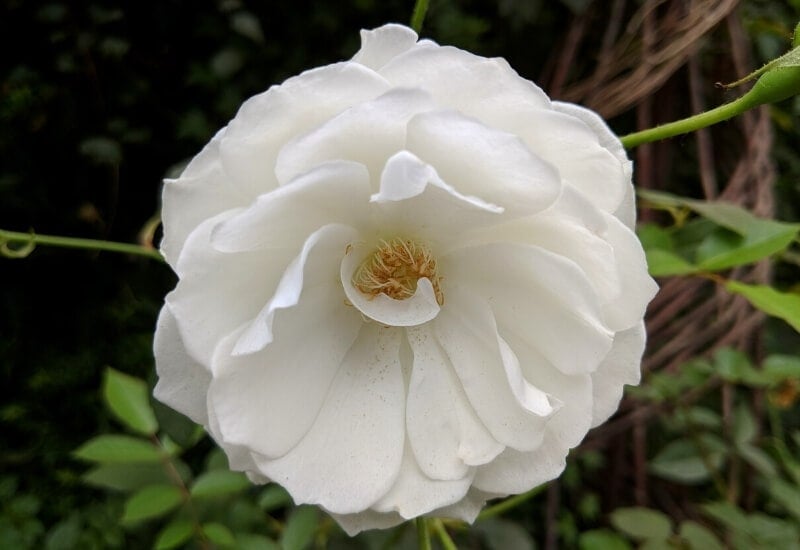
Floribunda roses are known to have many flowers each season. In many cases, these flowers persist for a large part of the season. This bloom period can last from spring to late fall.
The variety, ‘Korbin’ ICEBERG is no exception to this phenomenon. This variety blooms in May. In many cases the flowers will survive until the first frost of the year. During this time, the plant will repeatedly rebloom.
These flowers are large and typically pure white. At times they can have a subtle pink hue as well. The petals form around a yellow center part with small red dots.
Interestingly, this rose variety can come with very different growth habits. These include the usual shrub form as well as climbing and weeping varieties.
This plant is of medium size and an attractive branching habit. For the best blooms and the least maintenance needs, plant in full sun and slightly acidic soils.
Rosa ‘Wekpaltlez’ HOT COCOA (Floribunda Rose)
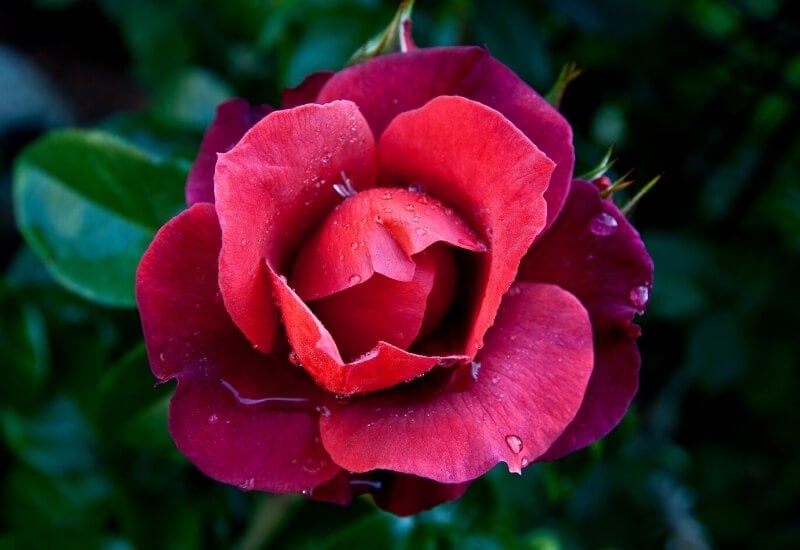
The HOT COCOA variety of floribunda rose comes with multiple darker features. The darkest of these is the new grow that emerges each year with chocolate color.
The leaves are also dark and have a very glossy texture. These leaves are compound and have less then ten leaflets. These leaflets look similar to the simple leaves of other roses.
The flowers of HOT COCOA rose carry on this dark theme. The petals of these flowers are in the red range. Their undersides are slightly darker then the color on the top of the petals. This color can also have tints of orange in it.
HOT COCOA rose is relatively new to nursery trade having been introduces in 2002. This type of rose has an admirable growth habit and good disease resistance. These characteristics are especially prominent when HOT COCOA grows in warmer climates with slightly acidic soil.
Rosa EUROPEANA (Floribunda Rose)
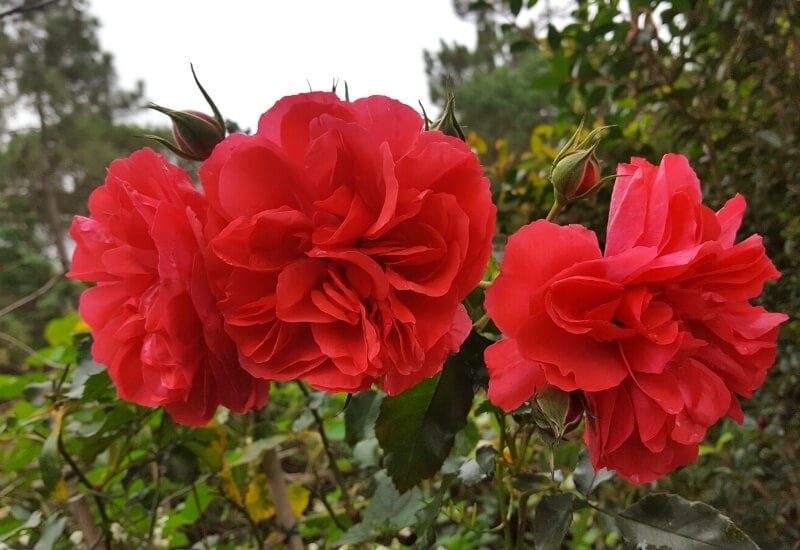
The blooms of the EUROPEANA cultivar come with a deeply saturated red color. The petals appear in multiple layers that encircle a button-like yellow stamen. These blooms emerge in clusters with a subtle pleasing fragrance.
The leaves also show a red hue, though only temporarily. This occurs when they first emerge in spring. Then this tinge of red cools to a more typical green color.
Although EUROPEANA has a vigorous growth habit, this amounts to a limited mature size. This cultivar forms a compact shrub with a maximum height below three feet. It tends to branch somewhat densely and in an upward direction.
While this rose is small, you need to remember not to perform overhead watering. This only increased the chance of your rose developing a disease. Despite this, soil must be kept moist on a regular basis.
Grandiflora Roses
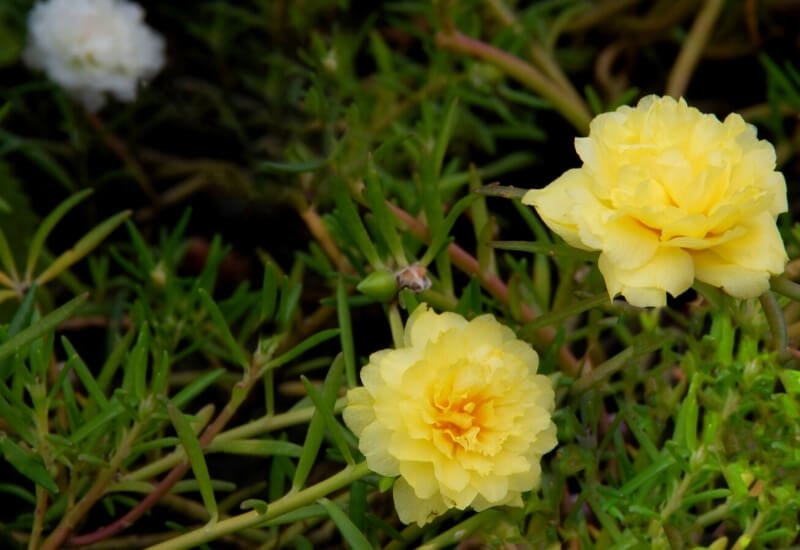
As a descendent of the hybrid tea rose group, grandiflora roses share a similar appearance. These roses also have long stems but typically have multiple terminal blooms rather than single solitary flowers.
Grandiflora roses are also larger that hybrid tea roses while still making for great cut flowers. These flowers often bloom multiple times throughout the season.
Take a look at some of the best varieties of grandiflora roses.
Rosa QUEEN ELIZABETH (Grandiflora Rose)
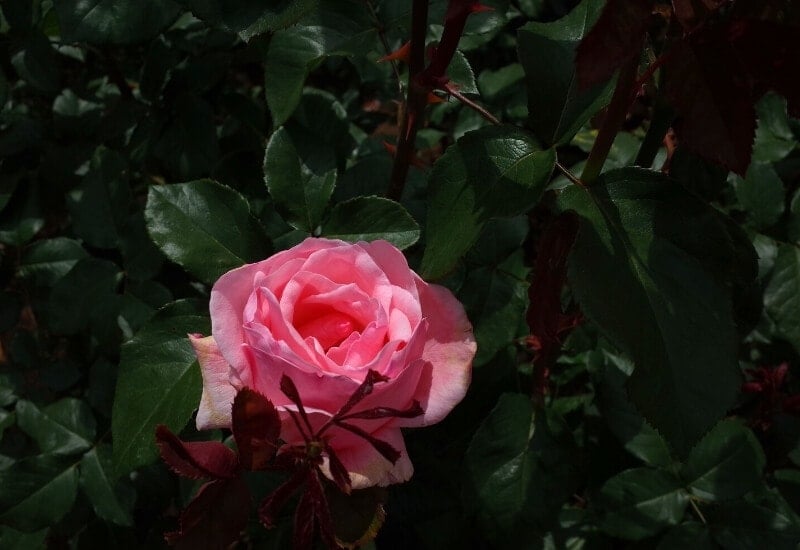
The ‘Queen Elizabeth’ variety of grandiflora rose has large fragrant flowers. These flowers bloom best in settings with full sun and organically rich soils.
Single and double flowers appear at the end of long stems. They are around four inches in diameter. The petals are smooth and pure pink. They curve slightly with the inner petals forming a cuplike shape.
The dark leaves are a great calming contrast to the showy flowers. The stems are known to have very few thorns making this plant easy to handle during pruning.
Light shade is acceptable but full sun is best. With six or more hours of sunlight, this rose variety becomes very disease resistant.
This grandiflora rose is tall and somewhat narrow. In most cases, it will display a vigorous growth habit. In any setting, it is a great specimen or accent plant.
Rosa ‘Wekisoblip’ WILD BLUE YONDER (Grandiflora Rose)
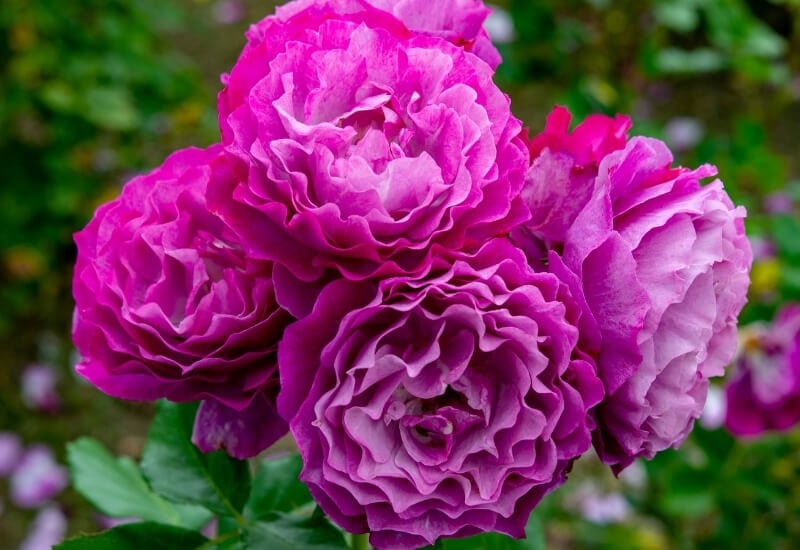
WILD BLUE YONDER is another grandiflora rose variety that has fantastic flowers. These appear with a purple or blue color from spring to fall.
The flowers have wavy petals that surround a dark yellow center. These flowers look best when this plant grows in a cooler area. They are also exceptionally fragrant.
Overall, this is an upright shrub that maintains a small size at maturity. Sometimes its habit and flowers look similar to those of a camellia.
David Austin Roses
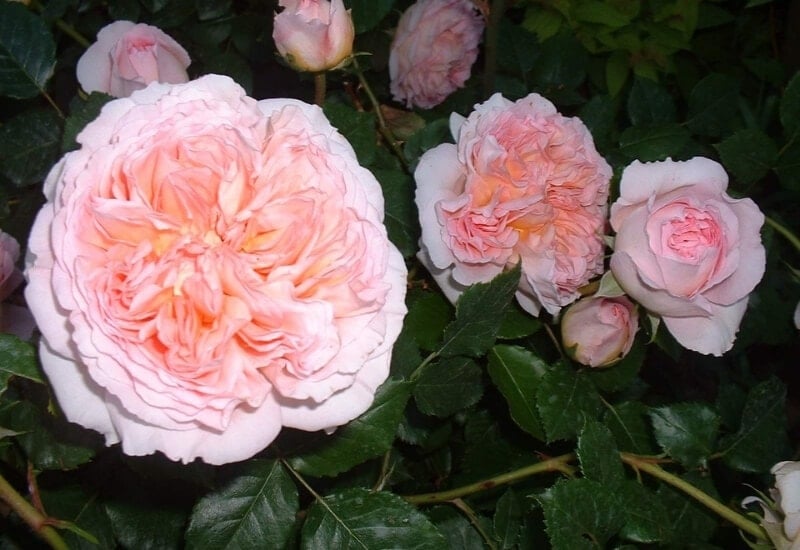
Not surprisingly, David Austin roses result from the efforts of English botanist David Austin. They also go by the name English roses.
Regardless of what you call them, the intent behind these roses was to combine hardiness with beauty. The result is a rose variety with the increased resilience of a modern rose and the visual character of older rose varieties.
The blooms of these roses repeat like other hybrid varieties. And they come in many lighter colors such as yellow and coral.
The varieties listed below are a great example of the David Austin group.
Rosa ‘Ausland’ SCEPTER’D ISLE (David Austinrose)
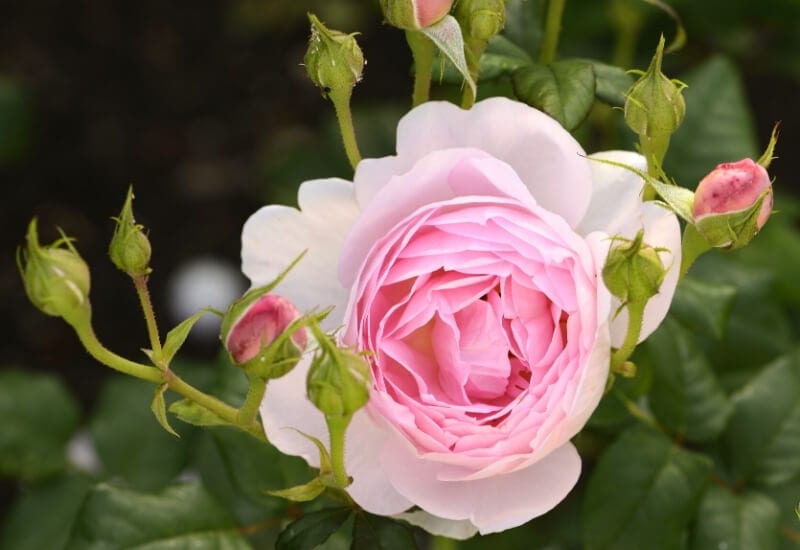
As is the case with many David Austin roses, the variety called SCEPTER’D ISLE has flowers that are both beautiful and fragrant. These flowers share the same continuous blooms as the other popular hybrid roses.
These flowers have a delicate pink color that borders on white. The are numerous enough to nearly conceal the otherwise prominent yellow stamens.
The leaves have a cool dark green color providing a nice contrast to the blooms. It has an upright habit and grows as a small shrub. Its obscure name comes from a Shakespeare quote features in the drama called Richard II.
Rosa ‘Golden Celebration’(David Austinrose)
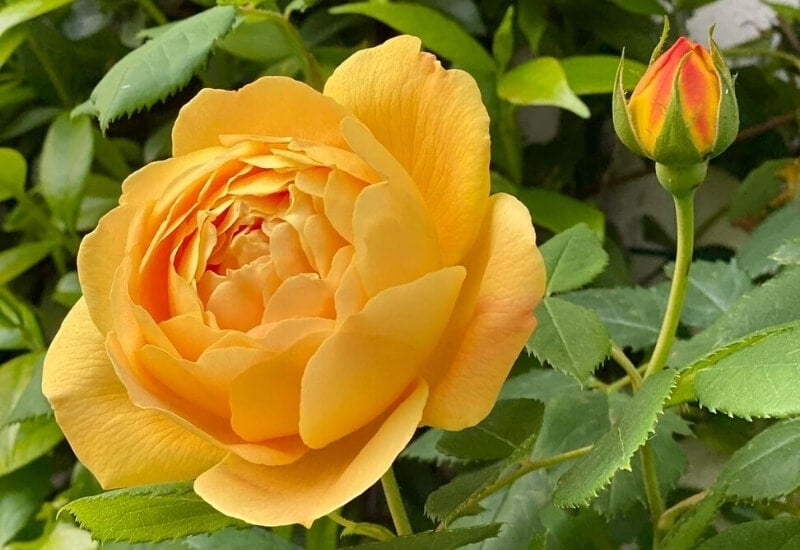
‘Golden Celebration’ has flowers that come with a high petal count. This umber can be as high as 75 petals per flower.
The color of these petals stands out from many of the other rose varieties. Rather than the more common red or pink, ‘Golden Celebration’ has rich yellow flowers.
‘Golden Celebration’ is also on the larger side in relation to other cultivated rose varieties. This narrow upright shrub can grow to reach about eight feet at its mature height.
This cultivar has a slight arch to its branching habit and can grow either as a shrub or as a climbing vine. In either case, it proves to have strong resistance to diseases.
Miniature Roses
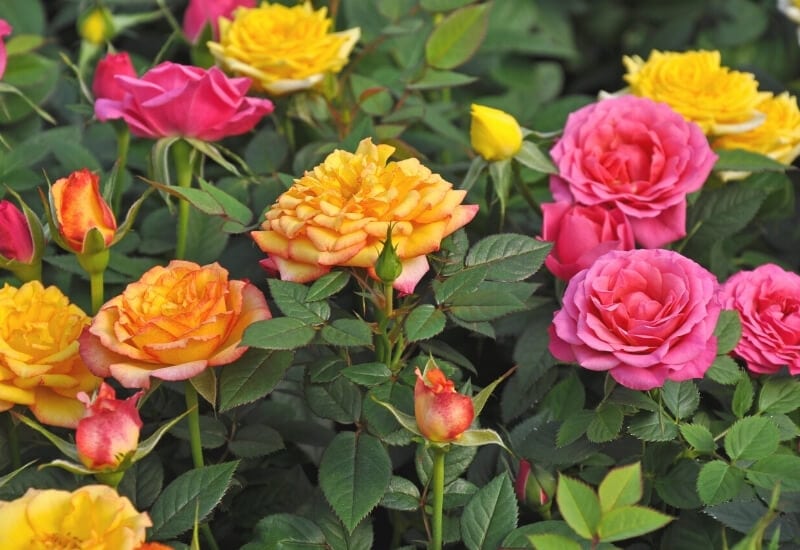
Miniature roses are exactly what they sound like they are. These plants are just smaller versions of regular rose plants.
This is true for the overall size and the size of each flower. Miniature roses were created to have this smaller size but also tend to have better winter hardiness then some other rose varieties.
While the size is decreased for these plants, the flower quality is not. These flowers bloom repeatedly and profusely. Miniature roses make for a great container plant.
Rosa ‘Savasach’ SACHET (Miniturerose)
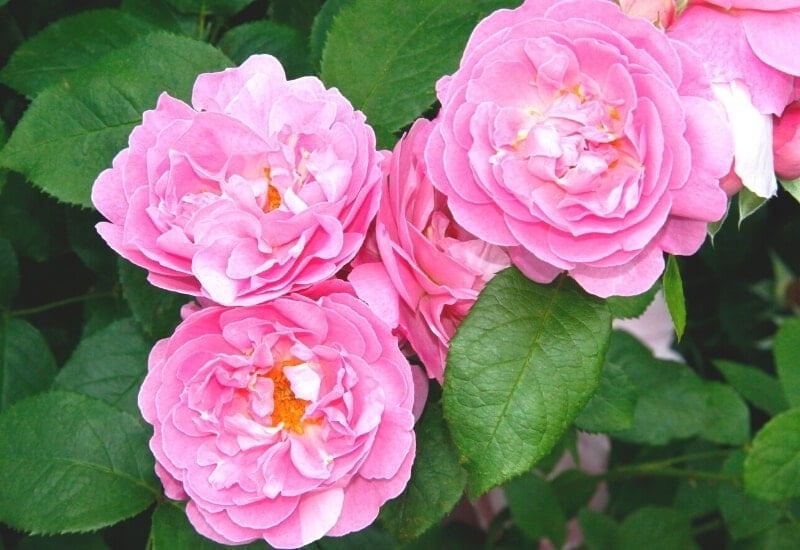
This miniature rose variety goes by the name SACHET in nursery stock. It grows to no more than two feet tall and has an upright branching habit.
Its flowers are less than two inches across and have many petals. These petals have a vibrant pink color, and they surround a yellowish orange stamen. These flowers can be solitary or grow in clusters.
SACHET is resistant to deer and has minimal thorns making it easy to handle. Its foliage is dark green and has a glossy texture.
Rosa ‘Scrivluv’ BABY LOVE (Miniturerose)
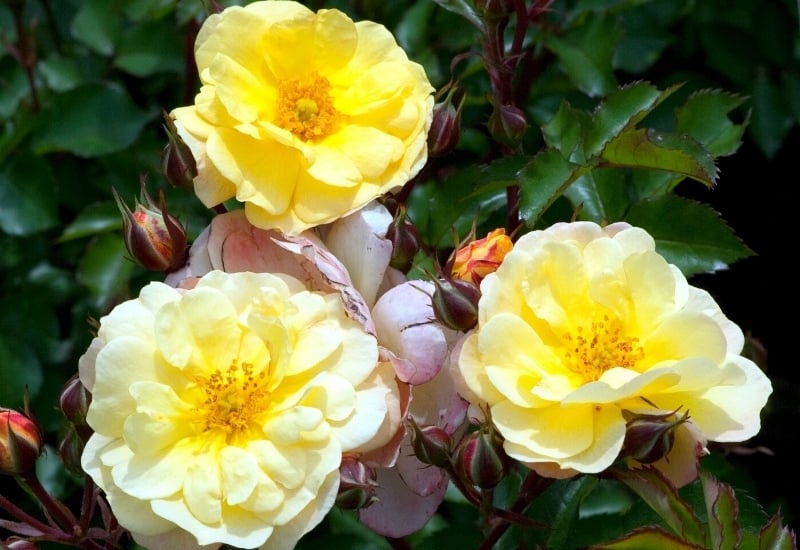
BABY love is a slightly larger miniature rose but is still small relative to other cultivars. This plant has a round shrub-like form that reaches four feet at most.
The flowers of this plant are light yellow and are flatter than man other rose blooms. This is partly due to the fact that this plant has far less petals than other roses. But this does not necessarily detract from their appearance. The yellow alone is enough to make this cultivar stand out.
Flowers have a unique fragrance and bloom in clusters for the entirety of the growing season. This plant grows best and has the highest disease resistance when planted in full sun locations.
Knock Out Roses
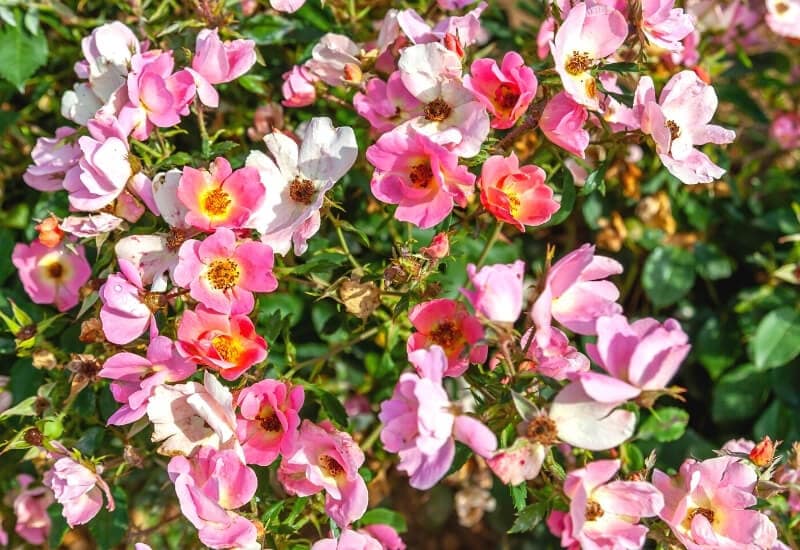
Knock Out roses have been commercially available for the past few decades. These rose shrubs are known for their long-lasting flowers and come in over ten colors.
Along with colorful flowers, Knock Out roses are easy to maintain. This makes them an extremely popular option for amateur gardeners.
Since so many people are interested in planting them, you should have no struggle finding Knock Out roses near you.
Here are some varieties to look out for.
Rosa ‘Radcor’ RAINBOW KNOCK OUT (Knock Out Rose)
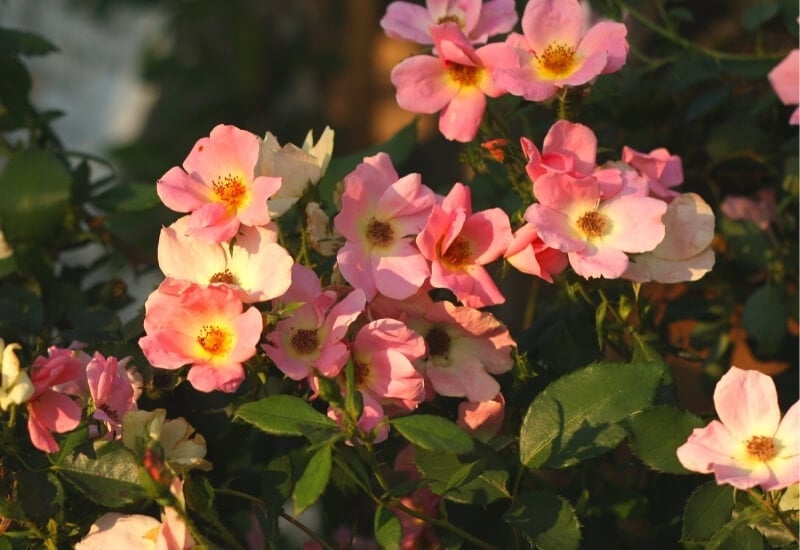
This variety, along with the other Knock Out roses,is hardy and has many blooms. These roses also typically have good disease resistance and a manageable mature size.
RAINBOW KNOCK OUT is about four feet in height and spread. Its flowers have a lovely coral color.
As another great feature of KNOCK OUT roses, this plant also performs some of its own pruning. There is no need to deadhead as This shrub rose will remove its spent flowers on its own.
Rosa ‘Radrazz’ KNOCK OUT(Knock Out Rose)
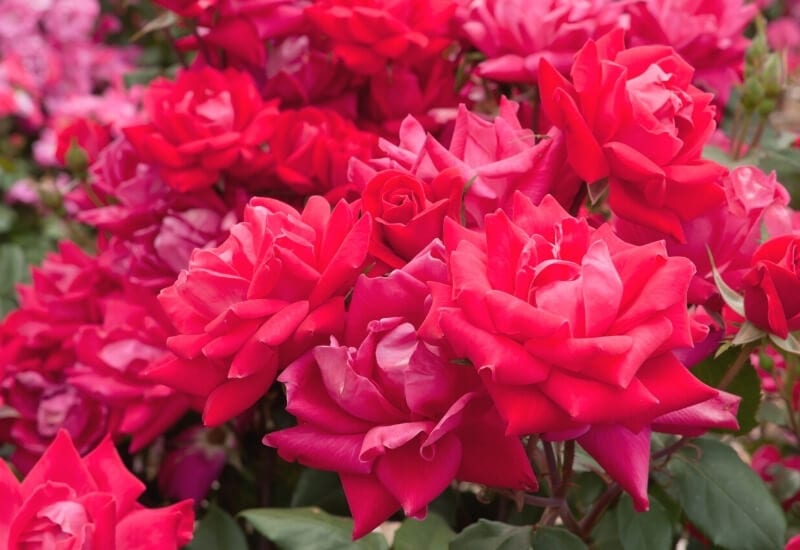
The variety ‘Radrazz’ is another of the many valuable Knock Out rose varieties. This Knock Out Rose is about three feet tall and wide at maturity.
The flowers of ‘Radrazz’ are a bright red that borders on magenta. These flowers are medium-sized and appear in dense clusters.
The foliage of this rose is green in the spring and summer. It then turns to maroon in Autumn. Along with these attractive features, ‘Radrazz’ is a rose variety with admirable disease resistance.
Climbing Roses
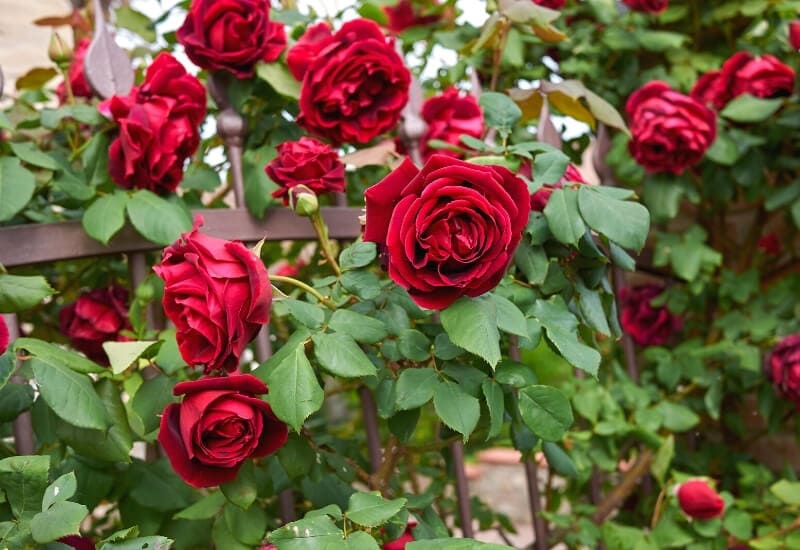
When blooms alone are not enough, roses continue to impress with variety in their growth habits. Some of the best examples of these forms come from the climbing rose varieties.
You can grow climbing roses on a trellis. Or you can grow them so they cover the top of a pergola or other garden structure.
Climbing roses belong to many different categories of roses. Some of these belong to the groups previously mentioned here. While general, the only defining characteristic of climbing roses is their growth habit. Here are some of the best options.
Rosa ‘ZéphirineDrouhin’ (Climbing Rose)
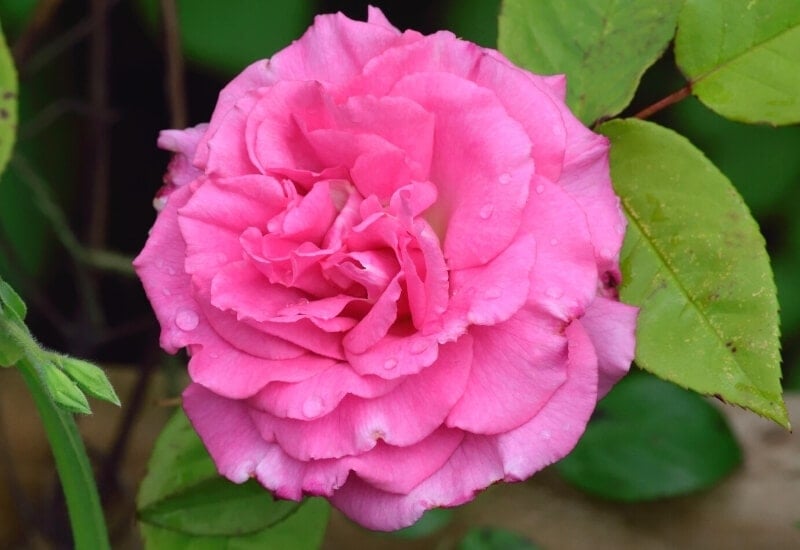
This rose variety appears most often in the form of a climbing vine. This growth habit is one of many features that gardeners find attractive in this cultivar.
‘ZéphirineDrouhin’ has an abundance of flowers with a strong fragrance. They bloom hot pink clusters. Burst open with around 30 curling petals.
Unlike many roses, this cultivar can handle a decent amount of shade. This only increases your planting options when finding a place for this climbing rose in your garden.
Rosa ‘Radsunsar’ CLIMBING CAREFREE SUNSHINE (Climbing Rose)
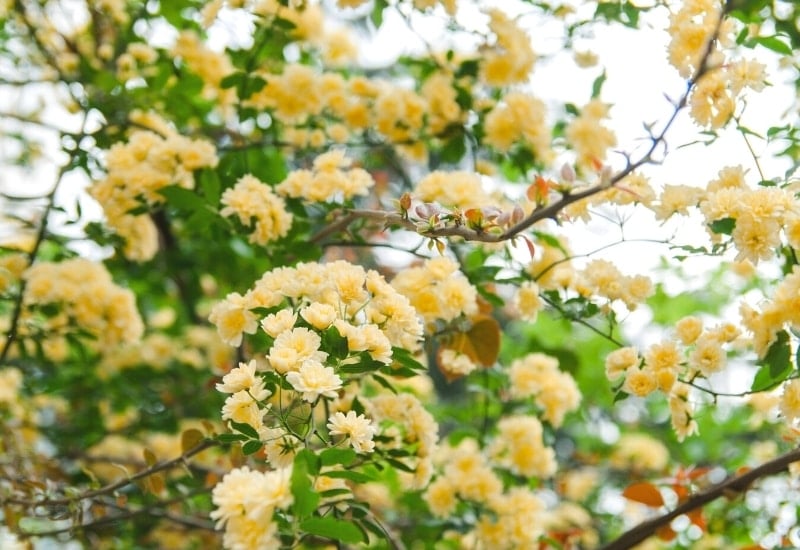
When reading the botanical name of this rose there is no mistaking its primary feature. This variety, called CLIMBING CAREFREE SUNSHINE, is known for its ability to climb.
This climbing rose often grows to ten feet tall. It is a relatively new variety having gained a patent only as recently as 2006. It is known to have an exceptionally upright form.
Additionally, this climbing rose has a striking bloom. The flowers are pale to deep yellow. They appear for the majority of the season.
Groundcover Roses
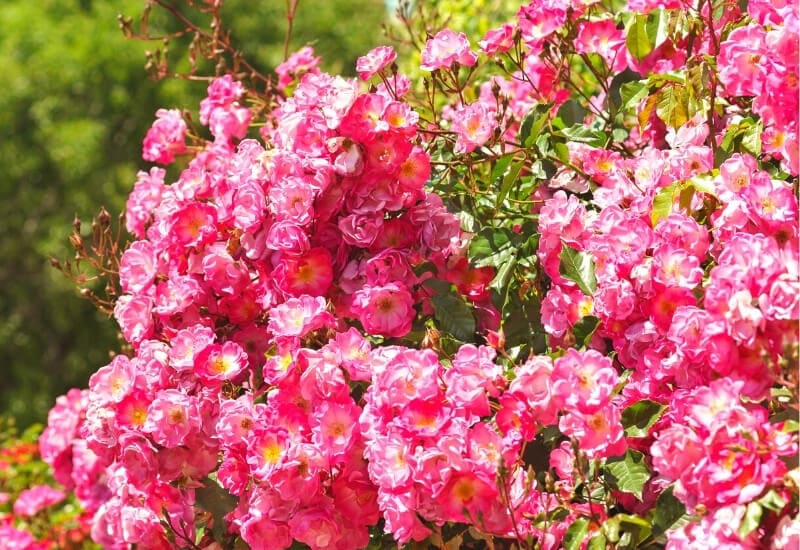
Many roses are small to medium-sized shrubs. Shrubs have their place in any garden. But sometimes you need a groundcover as well. There are plenty of roses that can serve that purpose.
Much like climbing roses, the only differentiating feature of a groundcover rose is its growth habit. Many of these plants are less than two feet tall. Often they spread to cover a much larger distance.
Many groundcovers lack color and simply act as a neutral backdrop. If you want a groundcover that is a bit more visually pleasing, a groundcover rose is a great choice. Try planting one of the following varieties.
Rosa ‘Meicoublan’ WHITE MEIDILAND (Groundcover Rose)
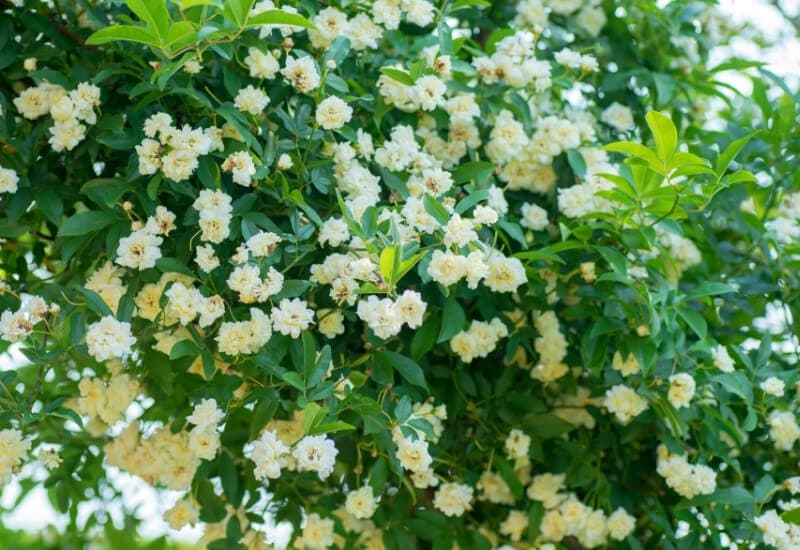
Here we have a prime example of a groundcover rose variety. This shrub rose often goes by its cultivated name, WHITE MEIDILAND, and grows no more than two feet tall. Its spread can be triple that size.
Along with this interesting form, WHITE MEIDILAND has plenty of flowers. These flowers are white and copious throughout the season. Its leaves are comparatively dark, glossy on the surface, and compound.
This variety originates as a part of a group cultivated in France. Among all creeping rose varieties, WHITE MEIDILAND offers one of the best examples of this spreading growth habit.
Rosa ‘Noare’ RED FLOWER CARPET (Groundcover Rose)
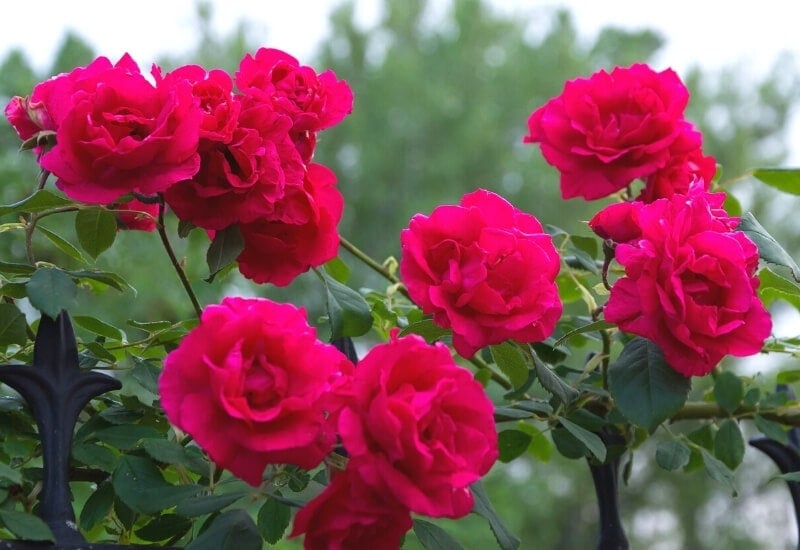
This ground cover rose is known as the RED FLOWER CARPET variety. It does not have the most extensive spread. But where it does grow, it only reaches two feet at maximum height.
This groundcover rose has flowers with vibrant red petals. The center of each flower is textured and yellow.
There are other varieties in the FLOWER CARPET group. They are distinct from one another simply by the color of their flowers. These include white and pink. All members of the group have a strong resistance to disease.
Wild Roses
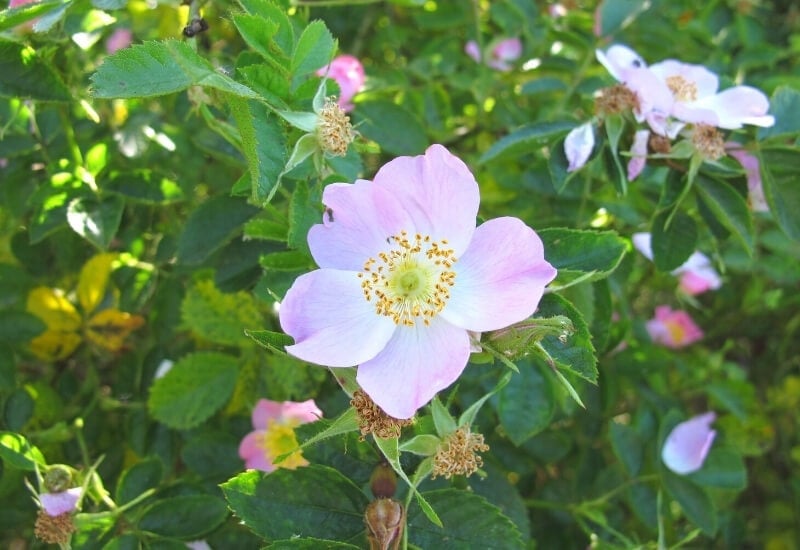
Soon you will see the high volume of cultivated rose varieties. But we will begin our list with rose species that came into being without the help of horticulturalists.
While the cultivars are the most popular in nursery trade, you’ll find that wild roses often have just as much ornamental value. These roses bloom with great colors and as much floral abundance as any others.
Along with attractiveness, wild roses support native species. The fruits of these plants are often edible hips. They grow with the volume as the flowers and are a reliable food source for browsing animals.
Yet as much as wild roses are a benefit to ecology, this is often only true if they are native. Our list includes a few non-native wild roses that should be planted only where they do not hold an invasive status.
Nonetheless, there are plenty of suitable wild roses for you to plant. Also, it is worth learning about these original roses species as a starting point. Then we can proceed to the many groups of cultivars.
Rosa Glauca (Shrub Rose)
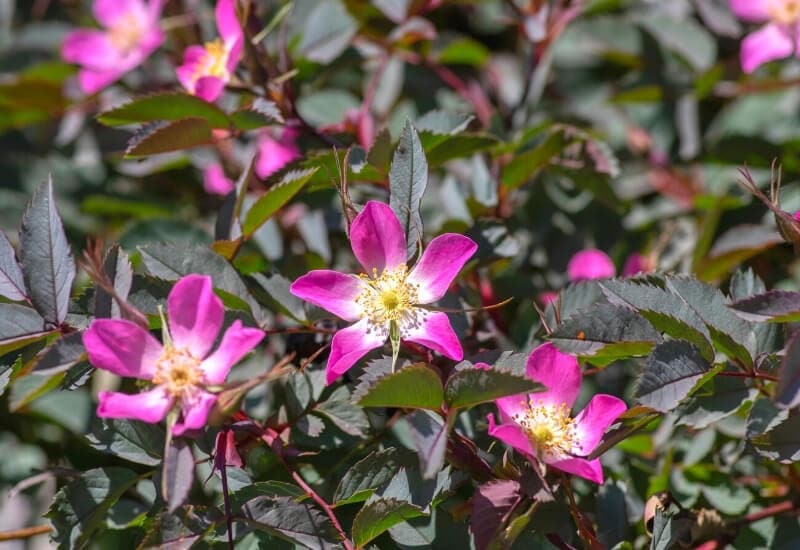
Shrub rose is a medium-sized woody shrub species native to Europe. It has colorful flowers and foliage.
The flowers are very small with a bright pink color. They have five petals that amount to less than one inch in total diameter. These flowers are known to have a subtle fragrance.
This is a rare rose variety that is as popular for its foliage as it is for its flowers. The deciduous leaves have a simple pointed shape and a dark purple color.
The overall form of shrub rose is vase-like. Yet, its width can often grow enough to match the total mature height.
Shrub rose presents many challenges to those who choose to plant it. First, it spreads via suckering. This can make it difficult to maintain and detracts from its vase form.
The other reason this plant is challenging is that it is vulnerable to many diseases. While there are many to list here, the best way to avoid these problems is to ensure ideal growing conditions.
These conditions include full sun, moderately moist soil, and good drainage. Regular watering and air circulation through the foliage are also very beneficial to this plant’s health.
Rosa Rugosa(Rugosa Rose)
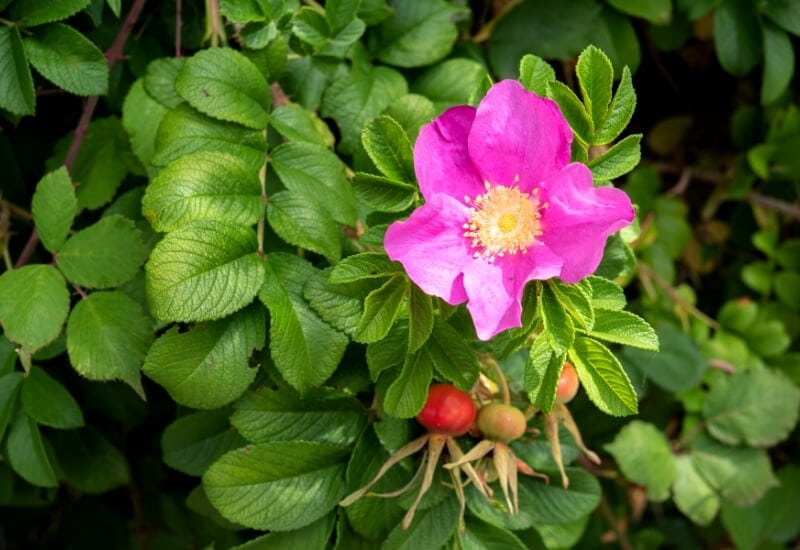
Rugosa rose often grows in large colonies along sand dunes throughout the United States. Despite its liking for these areas, this plant originates from Asia.
Due to its non-native origin and its ability to spread, some states consider this plant to be invasive. So, use caution when choosing whether or not to plant this shrub.
Rugosa rose has a loose irregular habit and a tendency to spread. It has suckers and a large number of sharp thorns along each branch.
This shrub blooms in May with pink flowers. Each flower has five petals and can appear alone or in a cluster.
A round one-inch hip replaces the flowers. This is an edible fruit with a bright red color. Late in the season, these fruits are nearly as showy as the flowers were previously.
The leaves are deciduous and compound. Each leaflet is small, somewhat thick, and has a rough texture. In fall they turn from green to yellow.
Unlike other rose varieties, rugosa rose is resistant to disease. It is also highly salt-tolerant which explains its affinity for beach environments.
Rosa Carolina(Carolina Rose)
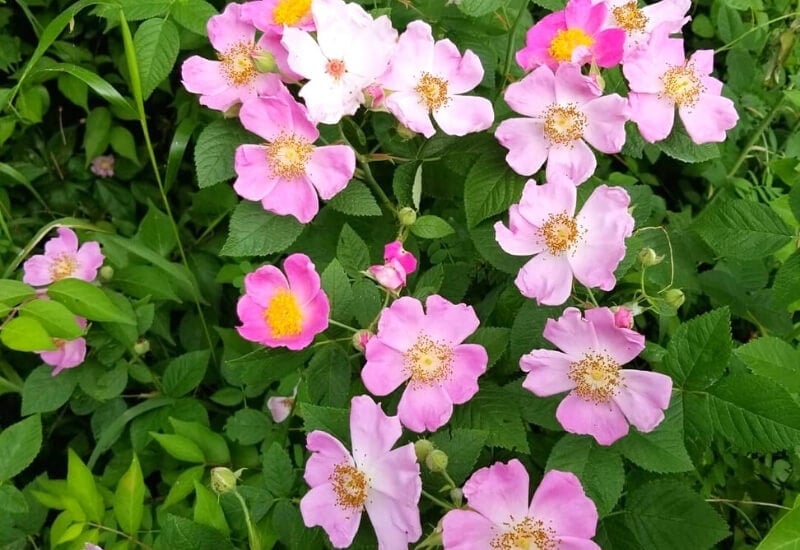
Carolina rose is a wide-spreading deciduous rose species. In its native range in the eastern United States, it grows in many settings including prairies and woodlands.
Carolina rose has pink flowers that bloom in May. They have five petals that surround a yellow center.
Following the flowers are red rose hips. These are rounded and have multiple small spikes.
The leaves have a simple shape and a smooth texture. They are oval-shaped and about two inches long.
To achieve the best floral result with this rose variety, plant it in full sun. Wet soils are also helpful for this plant.
As with other roses, Carolina rose can fall victim to many diseases. This shrub also spreads via suckering which can make it difficult to contain.
Rosa Xanthina (Manchu Rose)
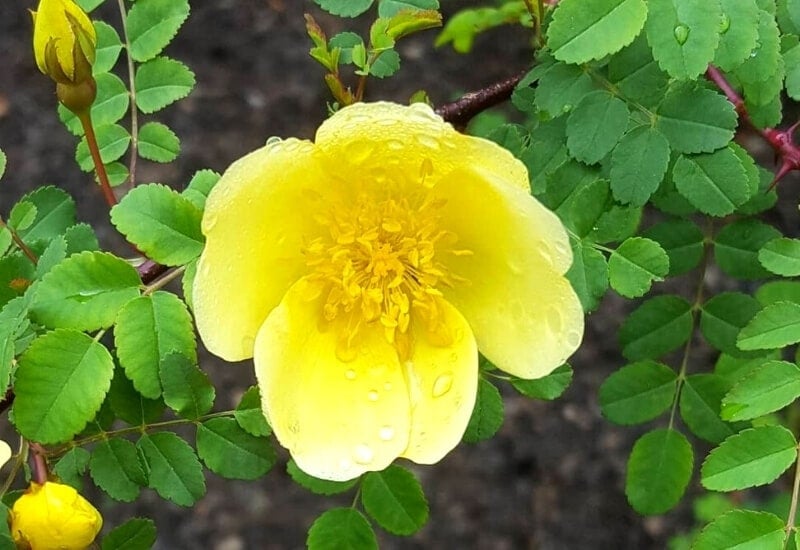
Manchu rose boasts an array of light yellow flowers in spring. These flowers are scattered across a loose spreading form.
These flowers are around two inches in diameter and have a distinct scent. When planted in ideal conditions, these blooms can be abundant. They also have the potential to appear a second time later on in the growing season.
Manchu rose grows best in soils with medium moisture and a high amount of organic material. Both part shade and part sun are sufficient for healthy growth.
You will find that this rose variety grows in a series of canes that reach upward before arching outward. These branches can have an appealing red tinge.
Machu rose has a strong ability to resist disease. Ensuring air movement through the foliage helps to promote this ability.
Rosa Rubiginosa (Sweet Briar Rose)
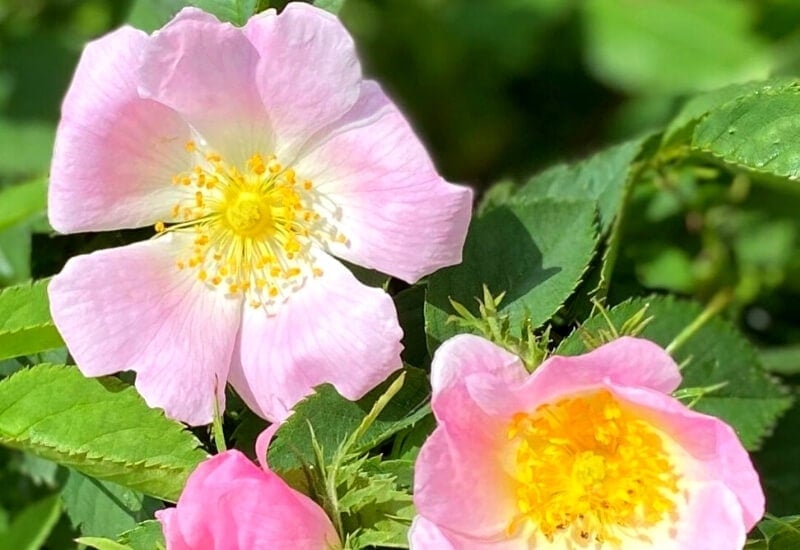
Sweet briar rose often grows in a wild manner along roadsides and other abandoned areas. This sprawling shrub comes from a large native range in Europe and Asia. It has since naturalized throughout North America.
This shrub is tough with an ability to fend off disease and grow in a wide range of soil acidity. It also has a dense growth habit and plenty of sharp thorns.
In contrast to these wild features, sweet briar rose is known to give off a pleasing fragrance. This originates in the dark deciduous foliage of this plant.
Along with these leaves, sweet briar rose has lovely flowers as well. These flowers are a blend of pink and white hues. After the flowers fade, the orange rose hips appear and persist for the second half of the year.
Sweet briar rose has the potential to grow in a vase form. But considering this plant is so inclined to spread in an irregular manner, you will need to employ focused pruning to achieve your desired form.
This pruning should take place in the late winter to early spring. In summer, give this plant a health layer of organic mulch to maintain soil moisture.
Rosa Multiflora (Multiflora Rose)
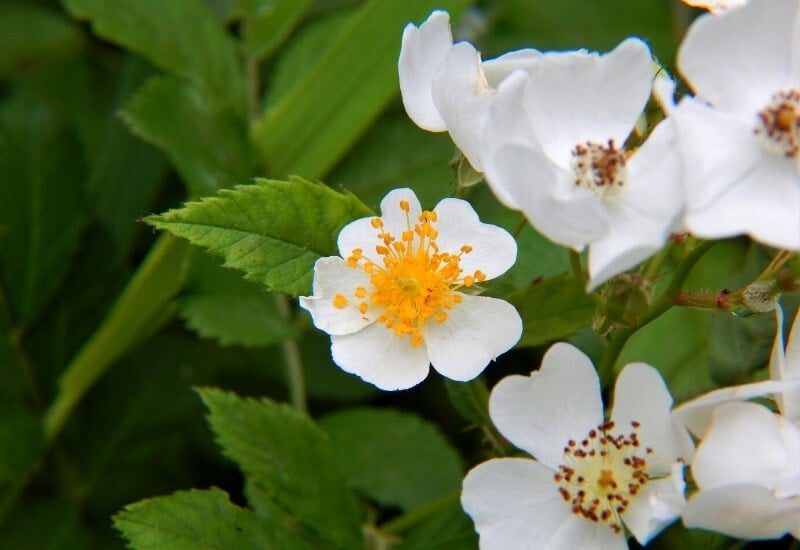
Multiflora rose offers a classic example of how invasive species come to dominate landscapes. This shrub arrived to North America from East Asia. It quickly gained popularity and widespread use because of its functional and aesthetic qualities.
Soon after, multiflora rose began to spread throughout many different ecosystems, out-competing native species in the process.
Today, multiflora rose remains one of the most notorious invasive species. Many nurseries no longer offer this species. Yet people remain attracted to multiflora rose for its multitude of flowers.
These blooms fill the branches in late spring. They are typically light pink. The leaves consist of multiple leaflets that have an oval shape.
Multiflora rose is a large shrub with dense but rapidly spreading growth. This is especially the case when this plant grows in full sun. However, multiflora rose grows in moderate levels of shade as well.
Rosa Laevigata (Cherokee Rose)
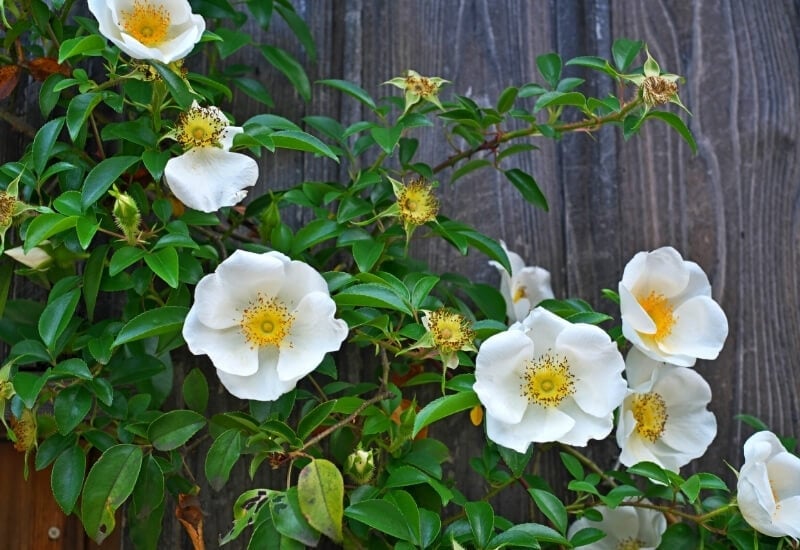
Cherokee rose has the potential to grow three times as tall as it is wide. This is because it has the ability to climb.
Despite this interesting habit, it is more common to see Cherokee rose grown in shrub form. This growth habit is easily achieved through some pruning.
As the common name implies, Cherokee rose has a long-standing association with the American landscape. Because of their affinity for this plant’s beauty, the Cherokee tribe spread this plant throughout the southeastern portion of the country.
However, this plant is not at all native to North America. Instead, it comes from China. As Cherokee rose has naturalized aggressively in many areas, it now holds an invasive designation in a few states.
Cherokee rose has evergreen foliage and hook-shaped thorns. Its flowers have yellow stamens and white petals with an overall size of four inches.
Disease resistance and a tolerance for varying sun exposure help this plant to spread rapidly. If your plant Cherokee rose, be sure to control this spread.
Rosa Setigera (Prairie Rose)
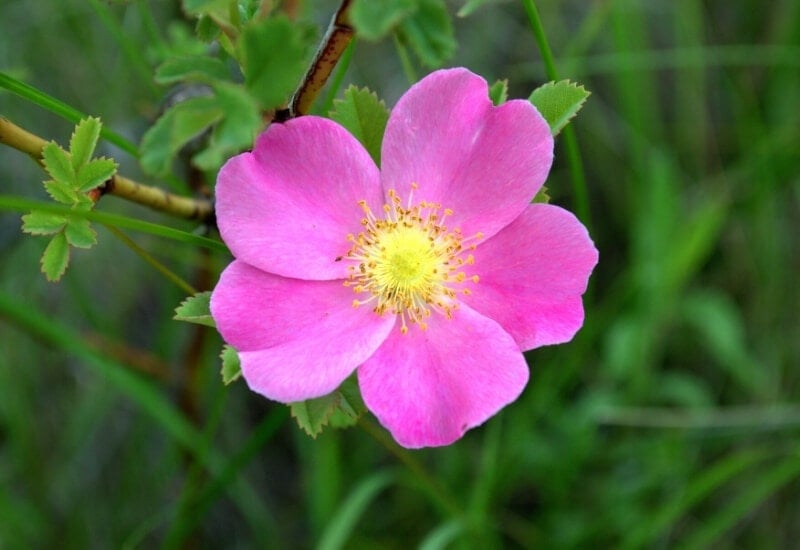
The unique growth habit of prairie rose allows it to both climb and spread. In either case, the growth of this plant often happens at a fast rate.
In June, prairie rose blooms with pink flowers. They have five petals and a slight fragrance as well. The color of these blooms can fade over time.
The foliage also has a dynamic color. This begins as dark green then turns red in the fall. The rose hips are red as well and appear around the same time that the foliage changes color.
Prairie rose is native to the United States. It grows in both the eastern and the central regions of the country. In this native range, it often occupies fields and other open areas.
Consider winter protection when planting this shrub in the colder parts of its range. Full sun allows for the highest amount of disease resistance for prairie rose.
Rosa Palustris (Swamp Rose)
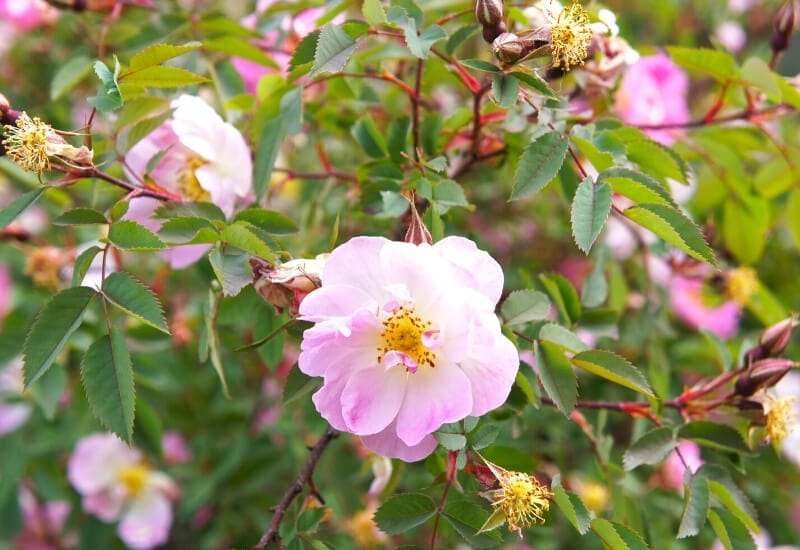
Swamp rose is familiar with growing in wet settings throughout a broad range of hardiness zones. In North America, where it is native, swamp rose lives in marshes and along streams.
The leaves on swamp rose are deciduous and compound. Leaflets come in sets of five or more leaflets each of which has a fine serration in its margin.
The flowers have a neat appearance. They hold five petals with a pure pink color. These encircle a flat yellow stamen.
Later in the growing season, the hips appear. They have a small berry-like appearance and are red. They also consistently turns red in the fall.
Plant swamp rose in wet soils. The soil should not regularly have standing water, but occasion flooding is permissible. Air circulation along with full sun and acidic soils are also an aid to swamp rose’s growth.
Rosa Banksiae ‘Lutea’ (Banksia Rose)
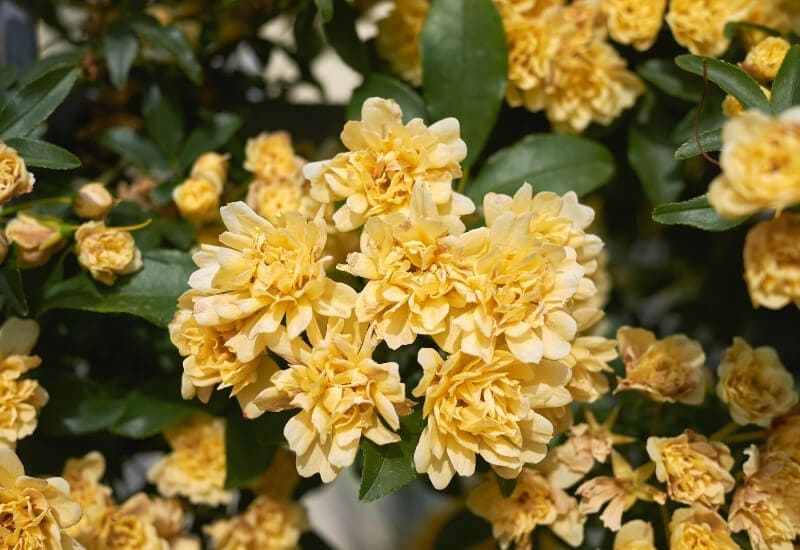
Banksia rose is a climbing species of rose with a high volume of striking flowers. The flowers bloom relatively early in the season and appear in pairs.
Each flower has many individual petals but is less than an inch across. On the parent species, these petals are white. For the variety ‘Lutes’ the petals are light yellow.
Banksia rose is native to Asia and only grows in warmer regions. In many parts of the United States, the winters are too harsh for this plant.
The foliage of this rose is compound and can be evergreen or semi-evergreen. This depends on the climate in which this plant is growing. The further north you plant banksia rose, the more likely it is to exhibit deciduous characteristics.
As is the case with many roses, banksia rose is susceptible to many diseases. Planting in the correct conditions helps to reduce this risk.
These conditions include full sun and moist acidic soil. Limit pruning to only the dead leaves and branches.
Best Roses to Grow
There are many options to choose from when it comes to roses. Many are cultivated varieties bred to be both tough and attractive.
Others are wild species that have equally impressive blooms and plenty of ecological value. No matter which variety you choose, you can expect your garden to be filled with the fragrance that drifts off those classic rose blooms.

Written By
Amber Noyes
Amber Noyes was born and raised in a suburban California town, San Mateo. She holds a master’s degree in horticulture from the University of California as well as a BS in Biology from the University of San Francisco. With experience working on an organic farm, water conservation research, farmers’ markets, and plant nursery, she understands what makes plants thrive and how we can better understand the connection between microclimate and plant health. When she’s not on the land, Amber loves informing people of new ideas/things related to gardening, especially organic gardening, houseplants, and growing plants in a small space.
